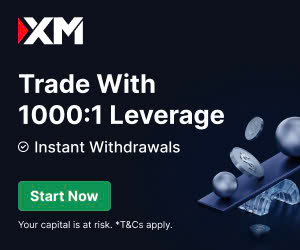
10 minute read
XM vs ThinkMarkets: A Comprehensive Comparison
The forex trading industry is highly competitive, with numerous brokers vying for traders' attention. Two prominent names in this space are XM vs ThinkMarkets, both offering a range of trading services, platforms, and tools tailored to beginners and experienced traders alike. Choosing the right broker can significantly impact your trading success, so understanding the differences between XM vs ThinkMarkets is crucial. In this comprehensive comparison, we’ll dive deep into their features, fees, platforms, regulation, and more to help you decide which broker suits your needs in 2025.

💥 Trade with XM now: Open An Account or Visit Brokers 🏆
Overview of XM vs ThinkMarkets
XM
Founded in 2009, XM is a globally recognized forex and CFD broker headquartered in Cyprus. It serves over 10 million clients across 190+ countries, offering access to more than 1,400 financial instruments, including forex, stocks, commodities, and cryptocurrencies. XM is renowned for its beginner-friendly approach, extensive educational resources, and low minimum deposit requirements. It operates under multiple regulatory bodies, ensuring a high level of trust and security.
ThinkMarkets
Established in 2010, ThinkMarkets is an Australian-based broker with a strong global presence. It provides access to over 3,500 trading instruments, including forex, indices, cryptocurrencies, and share CFDs. ThinkMarkets is known for its competitive spreads, advanced trading platforms, and robust regulatory framework. It caters to both novice and seasoned traders, offering a mix of user-friendly and sophisticated tools.
Regulation and Trustworthiness
Regulation is a critical factor when choosing a forex broker, as it ensures the safety of your funds and fair trading practices.
XM
XM is regulated by multiple top-tier authorities, including:
· Australian Securities & Investments Commission (ASIC) – Highly trusted Tier-1 regulator.
· Cyprus Securities and Exchange Commission (CySEC) – Ensures compliance within the EU.
· Financial Sector Conduct Authority (FSCA) – South Africa’s financial regulator.
· International Financial Services Commission (IFSC) – Belize-based regulation.
XM’s Trust Score is 88/99, reflecting its strong regulatory oversight and long-standing reputation. It does not operate as a bank or a publicly traded company but maintains segregated client funds for added security.
ThinkMarkets
ThinkMarkets is also well-regulated, with licenses from:
· ASIC – Australia’s premier regulator.
· Financial Conduct Authority (FCA) – UK’s stringent authority.
· Financial Sector Conduct Authority (FSCA) – South Africa.
· Dubai Financial Services Authority (DFSA) – Regulates operations in the UAE.
· Japanese Financial Services Authority (JFSA) – Ensures compliance in Asia.
With a Trust Score of 92/99, ThinkMarkets is considered highly reliable. It uses state-of-the-art encryption and segregated accounts to protect client funds, making it a secure choice for traders worldwide.
Verdict: Both brokers are highly regulated and trustworthy, but ThinkMarkets edges out slightly with its broader regulatory coverage, including the FCA and DFSA.
Account Types and Minimum Deposits
XM
XM offers four main account types:
· Micro Account: Ideal for beginners, with a $5 minimum deposit and smaller trade sizes.
· Standard Account: Also requires a $5 minimum deposit, suited for most traders.
· XM Zero Account: A low-spread account with a $5 minimum deposit and $3.5 commission per lot per side.
· Shares Account: Requires a $10,000 minimum deposit for trading real stocks.
XM’s low minimum deposit of $5 makes it highly accessible, especially for novice traders or those with limited capital. Islamic swap-free accounts are available across all account types.
ThinkMarkets
ThinkMarkets provides two primary account types:
· Standard Account: No minimum deposit, commission-free, with spreads starting at 0.4 pips.
· ThinkZero Account: Requires a $500 minimum deposit, offers spreads from 0 pips, and charges a $3.5 commission per lot per side.
ThinkMarkets also offers Islamic accounts and supports social/copy trading via ZuluTrade. A free VPS is available for traders meeting a minimum trading volume of 15 lots per month.
Verdict: XM is more beginner-friendly with its $5 minimum deposit across multiple account types, while ThinkMarkets appeals to traders seeking flexibility with no minimum deposit on its Standard Account.
Trading Platforms
The trading platform is the backbone of your trading experience, providing the tools and interface needed to execute trades effectively.
XM
XM is a MetaTrader-only broker, offering:
· MetaTrader 4 (MT4): The industry standard, known for its reliability, extensive charting tools, and support for automated trading via Expert Advisors (EAs).
· MetaTrader 5 (MT5): An advanced version with additional features like more timeframes, improved charting, and support for a broader range of assets.
Both platforms are available on desktop, web, and mobile devices. XM enhances MT4/MT5 with tools like Trading Central and copy trading via the MT Signals Market. However, it lacks a proprietary platform, which may limit customization for some traders.
ThinkMarkets
ThinkMarkets offers a more diverse range of platforms:
· MetaTrader 4 (MT4): Similar to XM, with full support for EAs and analytical tools.
· MetaTrader 5 (MT5): Provides advanced features for multi-asset trading.
· ThinkTrader: ThinkMarkets’ proprietary platform, known for its user-friendly interface, advanced charting, and TradingView integration. It’s available on desktop, web, and mobile.
ThinkTrader stands out for its modern design and additional tools like AutoChartist, making it a compelling choice for traders seeking an alternative to MetaTrader.
Verdict: ThinkMarkets offers more platform variety with ThinkTrader, while XM’s MetaTrader-only approach is reliable but less innovative.
Fees and Spreads
Trading costs, including spreads and commissions, directly affect your profitability.
XM
· Spreads: Variable spreads, starting at 0.6 pips on the Standard Account and 0 pips on the XM Zero Account. For example, the EUR/USD spread averages 1 pip on the Standard Account and 0.1 pip on the XM Zero Account.
· Commissions: No commissions on Micro and Standard Accounts; $3.5 per lot per side on the XM Zero Account.
· Non-Trading Fees: No deposit or withdrawal fees in most cases, but a $15 fee applies for bank withdrawals below $200. An inactivity fee is charged after 90 days of no activity.
XM’s spreads are competitive but average compared to industry leaders. Its commission-based XM Zero Account is cost-effective for high-volume traders.
ThinkMarkets
· Spreads: Variable spreads, starting at 0.4 pips on the Standard Account and 0 pips on the ThinkZero Account. The EUR/USD spread averages 1.2 pips on the Standard Account and 0.1 pip on the ThinkZero Account.
· Commissions: No commissions on the Standard Account; $3.5 per lot per side on the ThinkZero Account.
· Non-Trading Fees: No deposit or withdrawal fees. An inactivity fee may apply after prolonged inactivity.
ThinkMarkets generally offers tighter spreads, especially on its Standard Account, making it a more cost-effective choice for traders who prefer commission-free trading.
Verdict: ThinkMarkets has a slight edge with lower spreads on its Standard Account, while XM’s XM Zero Account is competitive for commission-based trading.

💥 Trade with XM now: Open An Account or Visit Brokers 🏆
Trading Instruments
The range of tradable assets is a key consideration for diversifying your portfolio.
XM
XM offers over 1,400 instruments, including:
· Forex: 55+ currency pairs, including majors, minors, and exotics.
· CFDs: Stocks, commodities, indices, precious metals, energies, and cryptocurrencies.
· Real Stocks: Available under the Shares Account for clients under the FSC-regulated entity.
While XM’s selection is robust, its CFD focus and limited real stock offerings may disappoint traders seeking broader market access.
ThinkMarkets
ThinkMarkets provides over 3,500 instruments, including:
· Forex: 46 currency pairs, focusing on majors and minors.
· CFDs: Indices, commodities, precious metals, energies, cryptocurrencies, and 1,500+ share CFDs.
· Spread Betting: Available for UK traders.
ThinkMarkets’ extensive share CFD offerings and crypto CFDs make it a better choice for traders looking to diversify across multiple markets.
Verdict: ThinkMarkets offers a wider range of instruments, particularly in share CFDs, while XM is strong in forex and CFDs.
Leverage
Leverage allows traders to control larger positions with less capital, but it varies by region due to regulatory restrictions.
XM
· Maximum Leverage: Up to 1000:1 for forex (CySEC-regulated entities may offer lower leverage, e.g., 30:1 in the EU).
· Limitations: No leverage for share trading, and leverage cannot be manually adjusted, which may limit risk management flexibility.
ThinkMarkets
· Maximum Leverage: Up to 2000:1 (varies by jurisdiction; FCA-regulated accounts are capped at 30:1).
· Flexibility: Leverage can be adjusted based on account type and asset class, offering more control.
Verdict: ThinkMarkets provides higher leverage and more flexibility, making it suitable for high-risk traders, while XM’s fixed leverage may appeal to conservative traders.
Educational Resources and Support
XM
XM excels in trader education, offering:
· Free webinars, videos, and Tradepedia courses.
· Daily market analysis, podcasts, and research tools via Trading Central.
· A demo account for practice.
Customer support is available 24/5 via live chat, phone, WhatsApp, and email, with multilingual options. XM’s support is highly responsive and beginner-friendly.
ThinkMarkets
ThinkMarkets provides:
· Webinars, articles, and a glossary for beginners and advanced traders.
· Market analysis updated regularly, including Trading Central and AutoChartist.
· Demo accounts and VPS hosting for active traders.
Support is available 24/6 via live chat, phone, and email, with a reputation for quick and professional responses.
Verdict: XM has a slight edge in educational content due to its extensive beginner-focused resources, while ThinkMarkets offers robust tools for all trader levels.
Deposit and Withdrawal Options
XM
· Methods: Bank transfers, credit/debit cards, e-wallets (Skrill, Neteller), and local payment options like GCash in some regions.
· Fees: No deposit fees; withdrawals are free except for bank transfers below $200 ($15 fee).
· Processing Time: Withdrawals typically take 1–2 days.
ThinkMarkets
· Methods: Bank transfers, credit/debit cards, e-wallets (Skrill, Neteller), and PayPal.
· Fees: No deposit or withdrawal fees.
· Processing Time: Withdrawals are processed within 1–3 days.
Verdict: ThinkMarkets offers more diverse payment options, including PayPal, while XM’s low-fee structure and fast withdrawals are competitive.
User Experience and Feedback
XM
XM is praised for its ease of use, low entry barriers, and reliable customer support. However, some traders report issues with slippage on pending orders and high spreads during volatile markets. As a market maker, XM takes the opposite side of client trades, which may raise concerns about potential conflicts of interest.
ThinkMarkets
ThinkMarkets receives positive feedback for its tight spreads, fast execution, and user-friendly ThinkTrader platform. Some users note occasional slippage on indices like US30 and NAS100, but overall, the broker is well-regarded for transparency and support.
Verdict: Both brokers have strong reputations, but XM’s market maker model may deter some traders, while ThinkMarkets’ transparency gives it a slight advantage.
Which Broker Should You Choose?
Choose XM If:
· You’re a beginner looking for a low minimum deposit ($5) and extensive educational resources.
· You prefer MetaTrader platforms and want access to a wide range of forex pairs and CFDs.
· You value responsive customer support and promotional offers like bonuses and competitions.
Choose ThinkMarkets If:
· You want tighter spreads and a broader range of trading instruments, especially share CFDs.
· You prefer a mix of MetaTrader and a proprietary platform (ThinkTrader) with advanced tools.
· You prioritize regulatory coverage from top-tier authorities like the FCA and DFSA.
Conclusion
Both XM vs ThinkMarkets are reputable forex brokers with unique strengths. XM is ideal for beginners due to its low entry barriers, extensive educational content, and MetaTrader exclusivity. ThinkMarkets, on the other hand, appeals to traders seeking competitive spreads, a wider range of instruments, and the innovative ThinkTrader platform. Your choice depends on your trading goals, experience level, and preferences for platforms and costs.
Before deciding, test both brokers with demo accounts to evaluate their platforms and execution quality. Always consider your risk tolerance and ensure you understand the complexities of forex and CFD trading, as both involve significant risks.
💥 Note: To enjoy the benefits of the partner code, such as trading fee rebates, you need to register with XM through this link: Open An Account or Visit Brokers 🏆
Read more:




